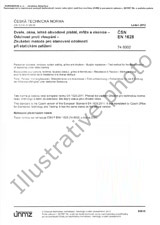We need your consent to use the individual data so that you can see information about your interests, among other things. Click "OK" to give your consent.
ČSN ETSI EN 300175-6-V2.7.1 (875011)
Digital Enhanced Cordless Telecommunications (DECT); Common Interface (CI); Part 6: Identities and addressing
Translate name
STANDARD published on 1.6.2018
The information about the standard:
Designation standards: ČSN ETSI EN 300175-6-V2.7.1
Classification mark: 875011
Catalog number: 504497
Publication date standards: 1.6.2018
SKU: NS-848687
The number of pages: 48
Approximate weight : 144 g (0.32 lbs)
Country: Czech technical standard
Category: Technical standards ČSN
The category - similar standards:
Annotation of standard text ČSN ETSI EN 300175-6-V2.7.1 (875011):
V2.7.1
The present document is one of the parts of the specification of the Digital Enhanced Cordless Telecommunications (DECT) Common Interface (CI).
The present document specifies the identities and addressing structure of the Digital Enhanced Cordless Telecommunications (DECT) Common Interface (CI).
There are four categories of identities to be used for identification and addressing in a general DECT environment. These four categories are:
- - Fixed Part (FP) identities;
- - Portable Part (PP) identities;
- - connection-related identities;
- - equipment-related identities.
Fixed part identities and portable part identities are used for:
- - access information from fixed parts to portable parts;
- - access requests from portable parts;
- - identification of portable parts;
- - identification of fixed parts and radio fixed parts;
- - paging;
- - billing.
These identities support:
- - different environments, such as residential, public or private;
- - supply to manufacturers, installers, and operators of globally unique identity elements with a minimum of central administration;
- - multiple access rights for the same portable;
- - large freedom for manufacturers, installers, and operators to structure the fixed part identities, e.g. to facilitate provision of access rights to groups of DECT systems;
- - roaming agreements between DECT networks run by the same or different owners/operators;
- - indication of handover domains;
- - indication of location areas, i.e. paging area;
- - indication of subscription areas of a public service.
The present document also provides for length indicators and other messages that can override the default location and/or paging area and domain indications given by the structure of the identities.
Connection related identities are used to identify the protocol instances associated with a call and are used for peer to peer communication.
Equipment related identities are used to identify a stolen PP and to derive a default identity coding for PP emergency call set up.
Coding of identity information elements for higher layer messages is found in ETSI EN 300 175 5 [5], clause 7.7.
User authentication and ciphering need additional key information and is outside the scope of the present document, but is covered in other parts of ETSI EN 300 175 [1] to [8], e.g. ETSI EN 300 175-7 [7].
The present document includes New Generation DECT, a further development of the DECT standard introducing wideband speech, improved data services, new slot types and other technical enhancements
Preview of the standard ČSN ETSI EN 300175-6-V2.7.1 (875011)
We recommend:
Technical standards updating
Do you want to make sure you use only the valid technical standards?
We can offer you a solution which will provide you a monthly overview concerning the updating of standards which you use.
Would you like to know more? Look at this page.




 Cookies
Cookies
